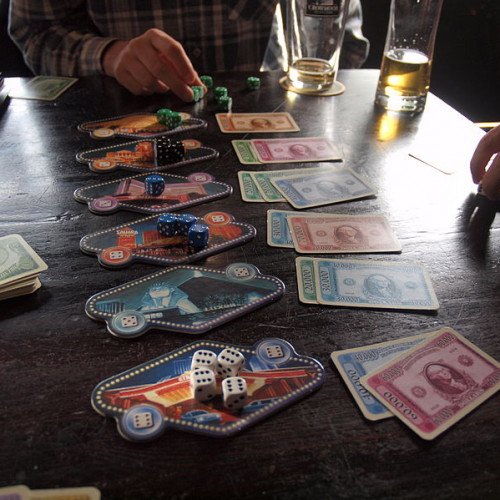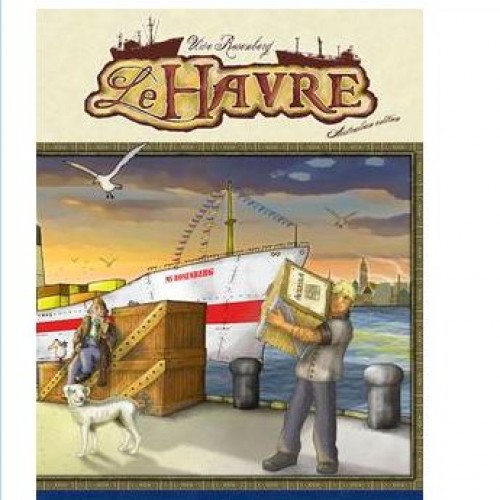"LAS VEGAS" vs "LE HAVRE"

LAS VEGAS
Las Vegas (US Release Title: Vegas Dice Game) is a board game designed by Rüdiger Dorn and published by Ravensburger in 2012. (The US Release came out in 2017.) It is named after the city of Las Vegas in Nevada, United States and has a gambling theme. The game was nominated for the Spiel des Jahres prize in 2012 and won the Årets Spel prize in the Best Adult Game category in 2013. Las Vegas is a game for two to five players. It consists of six small boards representing different casinos (originally depicting real Vegas casinos; later the same casinos with faux renamings; in the US release, simply numbered boards with similar decorative backgrounds), a deck of 54 "bills" (cards) in various denominations of the United States dollar (from $10,000 to $90,000 in $10,000 increments), an additional "First Player" card (denoting who starts each round of play) and five sets of eight dice, each set colored differently (orange, green, blue, black and white). The US release also included a dice pouch for storing the game dice. The game is played for four rounds. At the start of each round, each casino is randomly dealt a bill from the deck. Each casino must hold at least $50,000. If the bill's worth is less than that, the casino is dealt additional bills, until the casino holds at least $50,000. Players take turns throwing their dice. At the start of a round, each player is holding all of their eight dice. After the dice are thrown, the player must choose which casino they are betting on. This is done by choosing a number and placing all the dice showing that number on the respective casino. Betting is mandatory; there is no option to voluntarily pass a turn. A player can only pass a turn when he/she has no dice left for the round. Once all players have bet all their dice, the winnings are dealt out. For each casino, the winnings go to the player who bet the most dice on that casino. The majority has to be strict - on a draw, the winnings go to the player with the next most dice, or if all players are equal, the winnings go back to the deck. In case a casino holds multiple bills, the top player receives the largest bill, and the smaller ones in order of decreasing value are awarded to the runner-up players, with unawarded bills being returned to the deck.
Statistics for this Xoptio

LE HAVRE
Le Havre is a board game about the development of the town of Le Havre. It was inspired by the games Caylus and Agricola and was developed in December 2007. The game was edited by Uwe Rosenberg and Hanno Girke and the former gets the main cover credit. The illustrator was Klemens Franz while the English translator was Melissa Rogerson. Numerous credits are given to others who assisted with playtesting and other tasks. The game was published by Lookout Games and distributed by Heidelberger Spieleverlag. The game was released at Spiel 2008 in both German and Australian English, with both editions published by Lookout Games. It did not do as well as its predecessor Agricola in the Fairplay polls, with a rating of 2.51 (1 is best), but has a high rating of 8.1 at BoardGameGeek (a different rating system), and is generally considered to be highly regarded by critics. The game was adapted into an iOS app by Codito Development Inc. and released on Jun 21, 2012. The game has a Metacritic rating of 82% based on 6 critic reviews. A two player version called Le Havre: The Inland Port was released in 2012. There is also a corresponding iOS app. The gameplay takes place in the harbour of Le Havre, where players take goods such as fish and wood from the wharves. These goods are used either to feed the players' community, to construct buildings and ships, or are processed into finished goods. For example, a smokehouse building may be constructed in which players may process fish into smoked fish, which is more valuable. The game is played for a set number of rounds. The winner is the player with the greatest net wealth at the end. Points are earned by making money, building buildings and ships (which each have their own values), and selling goods. At the end of each round, players must be able to give food to their workers. The amount of food depends on the number of players; it starts out low and steadily increases to high values towards the end of the game. Players not planning ahead will soon find themselves with a shortage of food which will require taking loans from the Bank. Building ships can help with this food problem, as each ship will give the player a discount on their food each round (they count as trade routes which give the player more sources of food).